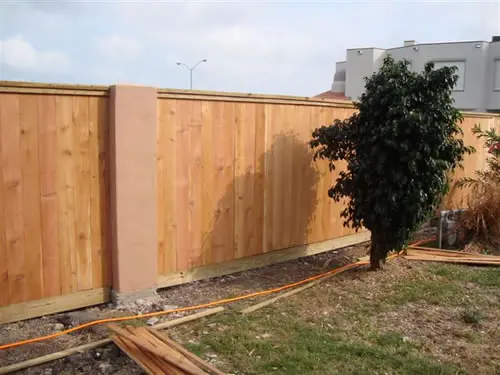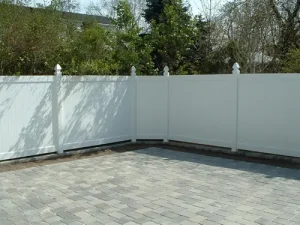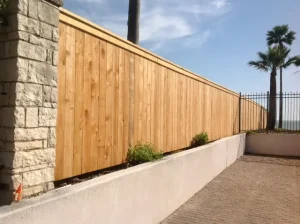![The Great Fence Debate Wood Versus Vinyl [How to Choose]](https://www.dcfence.com/wp-content/uploads/2024/04/The-Great-Fence-Debate-Wood-Versus-Vinyl-How-to-Choose-300x157.webp)
The Great Fence Debate: Wood Versus Vinyl [How to Choose?]
When it comes to enhancing the privacy, security, and aesthetic appeal of your home, few elements play as pivotal a role as your choice of

In the realm of property management, the significance of a sturdy fence cannot be overstated. It serves a myriad of purposes – from safeguarding your property and maintaining privacy to enhancing aesthetic appeal.
However, fences, like any other structure, are susceptible to damage. Factors such as weather conditions, pests, accidental impacts, and natural wear and tear can compromise their integrity and necessitate immediate repair. This article serves as a comprehensive resource, detailing methods, tips, and best practices to restore your fence to its optimal condition.
Here’s how professionals go about addressing the problem:
Initial Visual Inspection: They start by visually inspecting the damaged fencing. This helps them spot any visible signs of damage like broken or displaced fence panels, posts, or gates. It gives them a good overview of what needs to be fixed.
Identifying Structural Issues: Going beyond the surface, professionals take a closer look to identify any structural issues. They check the integrity of the fence and its components. For example, they examine if there’s any structural damage to the fence posts, connections, or foundational elements.
Evaluating Safety Risks: Safety is their top priority, especially in emergency situations. During this phase, they assess any safety risks posed by the damaged fencing. They make sure to identify sharp or protruding objects, unstable sections, or any hazards that could potentially harm people or property.
By thoroughly assessing the damage in these ways, professionals can make informed decisions regarding the necessary repairs and safety measures. Their goal is to restore the fencing to a secure and functional condition.
When it comes to repairing your fence, it’s crucial to understand the tools and materials you’ll need. Let’s break it down.
Firstly, you’ll want to have a few specific tools handy, such as screwdrivers, pliers, saws, post-hole diggers, a level, measuring tape, a hammer, wire cutters, wrenches, a power drill, and a mallet. These tools will help you tackle any repairs or adjustments.
However, the type of fence you have will determine the materials you’ll need. Whether it’s wood, chain link, vinyl, wrought iron, or aluminum, each material has its own unique qualities and uses.
Lastly, safety should always be a top priority when working on your fence. Make sure to wear protective clothing, eye protection, hearing protection, dust masks, and a respirator if needed. Keep a first aid kit and a fire extinguisher nearby, just in case.
Understanding these tools, materials, and safety equipment is essential to ensure that your fence repairs are done efficiently and safely.
Temporary fixes are immediate solutions to address safety and security concerns until a more permanent repair can be made. These temporary fixes are especially valuable in urgent situations where a damaged fence poses risks, such as exposing a hazardous area or compromising security. They typically involve the following key aspects:
Quick Solutions for Immediate Safety and Security: These are simple yet effective actions taken to secure the damaged area. For instance, if a section of a fence is knocked down, a quick solution might involve placing barriers or temporary fencing to keep people or animals from entering a potentially dangerous zone.
Temporary Support Structures: In cases where fence posts or supporting structures are compromised, a temporary fix may include bracing or shoring up the damaged section. This could involve using additional wooden or metal supports to prevent further collapse.
Using Tarpaulins and Boards for Covering Gaps: To maintain privacy, security, or safety, you might use materials like tarpaulins and boards to cover gaps or openings in the fence. This serves as a short-term measure to prevent unauthorized access or to conceal what’s beyond the damaged area.
These temporary fixes are practical in emergency situations, buying you time to plan and execute a more comprehensive and lasting repair. It’s important to remember that these solutions are not substitutes for proper, permanent repair but are valuable stopgaps to address immediate concerns while ensuring safety and security.
When it comes to fixing wooden fences, the process involves restoring both the structure and the look. That means dealing with things like replacing worn-out pickets and panels that can mess up the fence’s appearance and function. And don’t forget about those broken or wobbly fence posts – they need reinforcement or replacement and a good solid anchor.
Finally, the last step is all about bringing that fence back to its former glory. Think sanding, refinishing, and making those wooden surfaces look top-notch. To keep your wooden fence in tip-top shape, regular maintenance, and timely repairs are a must. It’s all about making sure it stays visually appealing and functional for as long as possible.
When it comes to fixing chain-link fences, the main goal is to restore their functionality and structural stability. The first thing to address is any bent or broken links, as these can compromise both the security and appearance of the fence. This might involve straightening out the bent links or replacing ones that are severely damaged.
It’s also important to take care of any damaged posts and rails to ensure the fence remains upright and sturdy. And if there are gates involved, we need to adjust the tension and make sure they open and close smoothly.
When it comes to restoring vinyl and PVC fences, the main goal is to bring back their appearance and structural integrity. Patching up holes and cracks in vinyl fences is a common task, usually done using special patching materials that match the fence’s color. If certain parts of the fence are beyond repair, replacing damaged sections or panels may be necessary.
It’s important to keep the fence looking good and durable through regular cleaning and maintenance. This includes routine inspections and cleaning to prevent mold or mildew buildup and make sure the fence remains visually appealing. By taking these steps, you can ensure that the fence remains an attractive and functional addition to your property.
When it comes to repairing metal fences, professionals utilize techniques such as welding and soldering. These methods are employed to fix any broken or detached metal components, ensuring the fence is structurally sound once again. Given the susceptibility of metal fences to rust and corrosion, particularly in humid or coastal areas, it is imperative to address these issues promptly.
To halt the spread of rust and prevent further corrosion, professionals employ various rust converters and primers. Additionally, weak sections are reinforced by adding extra metal supports or bracing, guaranteeing the fence remains stable and resilient. These repairs play a critical role in maintaining the functionality and appearance of metal fences, allowing them to effectively serve their intended purpose.
Concrete and masonry fences can develop cracks and chips over time due to weathering and wear. To address this issue, professionals recommend repairing these cracks and chips to prevent further deterioration. This involves filling the cracks and chips with suitable patching materials to restore the fence’s appearance and strength.
In cases where the damage is extensive, professionals may opt to replace damaged sections. This may require the removal and replacement of entire sections, such as damaged concrete or masonry blocks. The primary goal is to ensure the structural integrity of the fence.
Additionally, it is crucial to apply sealants and protective coatings to maintain concrete and masonry fences. These coatings play a vital role in safeguarding the material from moisture, staining, and other environmental factors. They not only prolong the lifespan of the fence but also help it maintain a fresh and appealing look.
Sometimes, when it comes to extensive or complex fence damage, DIY repairs may not cut it. That’s when it’s a good idea to bring in a professional fencing contractor. You know it’s time to call in the pros when you’ve got some serious structural issues, need large-scale replacements, or have complicated repairs on your hands.
Now, choosing the right repair service is key. Do your research, read those reviews, and ask around for recommendations. You want to make sure you’re working with a reliable and experienced provider. Oh, and don’t forget to double-check their licensing and insurance to keep yourself and your property protected.
Of course, budgeting is important too. Fencing repair costs can vary based on things like materials, labor, and the extent of the damage. Reputable contractors will give you detailed estimates to help you plan financially for your repair project. It’s all about being prepared!
Taking care of your fence through preventive maintenance is crucial to keep it in great shape for the long haul. Being proactive and doing routine tasks helps prevent damage and decay over time.
Regularly inspect your fence to catch and fix issues early. Look for wear and tear, loose parts, or damage from weather or critters. Don’t forget to tighten screws, give it a fresh coat of paint, or clean it to stop small problems from worsening.
Remember, different seasons bring different challenges. In winter, clear away snow or ice to prevent damage. In summer, watch for signs of rot or fading due to the sun. Adjust your maintenance routine to each season to protect your fence.
Take preventive measures to keep your fence safe. Use weather-resistant coatings, install pest deterrents, or strengthen its structural components.
By staying on top of preventive maintenance, you can keep your fence looking good, avoid costly repairs, and ensure it lasts for a long time.
When doing DIY fence repair or maintenance, prioritize safety. Here are some essential tips to remember:
Use proper safety gear: Wear gloves, safety goggles, ear protection, and, if necessary, a dust mask. Depending on the task, consider knee pads or steel-toed boots for added protection against injuries.
Handle tools and materials with care: Learn how to use tools and materials correctly. Follow manufacturer instructions for safe operation. Keep tools in good condition, replacing or repairing any damaged equipment. Be cautious with sharp or heavy items to avoid cuts or injuries.
Prevent common accidents: Stay aware of common accidents and how to avoid them. Keep hands and body parts away from moving parts when using power tools. Use a sturdy, properly secured ladder when working at heights to prevent falls. Keep your work area clean and organized to minimize tripping hazards.
By following these DIY safety tips, you can reduce the risk of accidents and injuries while working on fence repairs or maintenance. Your well-being is always the top priority when tackling DIY projects.
When repairing or maintaining your fence, it’s important to consider the environment. Here are key points to keep in mind:
Sustainable fencing materials: Choose eco-friendly options like reclaimed wood, bamboo, or recycled composite materials instead of pressure-treated wood.
Impact of repair techniques: Avoid using harmful chemicals that can harm local ecosystems. Opt for methods with minimal environmental impact.
Responsible waste disposal: Properly handle and dispose of waste materials. Recycle or repurpose old materials and follow local regulations for hazardous waste.
By considering these factors, you can contribute to an eco-friendly approach to fence repair and maintenance that aligns with sustainable living and responsible construction practices.
When it comes to fixing your fence, there are a few important legal and insurance things to keep in mind. Here’s what you need to know:
Take a look at your homeowner’s insurance policy before you start. It’s good to know what’s covered in case of things like storm damage. Understanding your coverage will help you decide whether to file a claim or pay for repairs yourself.
Safety first! If you’re hiring a contractor, make sure they have liability insurance in case anything goes wrong. And don’t forget to check your property boundaries to avoid any neighborly disputes.
Don’t forget to check with your local government to see if you need any permits for your fence repairs. They may have rules about height, materials, or location. Following these rules will keep you out of any legal trouble.
By keeping these legal and insurance things in mind, your fence repair process will be smooth sailing without any complications.
When it comes to fence repair, assessing irreparable damage is crucial, especially if it’s severe. Firstly, you must recognize signs of irreparable damage like extensive rot, severe structural issues, or complete destruction.
Additionally, safely remove the damaged fence by dismantling the existing structure, including posts and panels. Also, plan for replacement by choosing new materials, designs, and installation methods.
Lastly, consider alternative fencing options to address any shortcomings and meet specific needs. Overall, you must assess beyond repair to make informed decisions about your damaged fence and explore new and improved solutions when necessary.
To sum it up, fixing a fence involves a few important steps. First, you need to assess the damage and figure out what tools and materials you’ll need. Then, you can use the right techniques based on the type of fence you have. It’s also crucial to know when a fence is beyond repair so you can replace it or consider other options. By understanding the repair process and acting quickly, you can keep your property safe and secure.
Whether you want to repair an electric fence, use thick cardboard for temporary repairs, or hire professionals to get quality workmanship, you must know the basics in order to make the right choice.
Emergency repairs are no joke because they might come after natural disasters. Therefore, if you have a split rail, loose wires, or overall require a temporary fence, make sure you’re deciding correctly.
It’s worth mentioning that regular inspections and seasonal upkeep are key to preventing major damage and saving on repair costs. Taking care of your fence proactively will help it last longer and keep your property looking great. So, don’t forget to give your fence the attention it deserves!
By submitting, you agree to receive emails from Uscreen and to our privacy policy.
![The Great Fence Debate Wood Versus Vinyl [How to Choose]](https://www.dcfence.com/wp-content/uploads/2024/04/The-Great-Fence-Debate-Wood-Versus-Vinyl-How-to-Choose-300x157.webp)
When it comes to enhancing the privacy, security, and aesthetic appeal of your home, few elements play as pivotal a role as your choice of

PVC (Polyvinyl Chloride) fencing is a type of synthetic plastic fence that offers a modern alternative to traditional materials like wood and metal. Distinguished by

Wood fences are one of the most traditional and versatile types of fencing used to delineate property lines, enhance privacy, and contribute to the aesthetic
Complete the form below and a representative will contact you shortly.